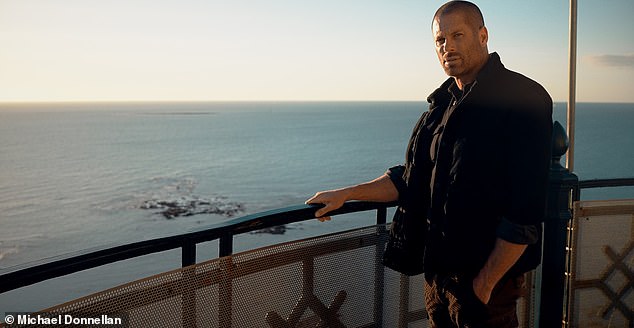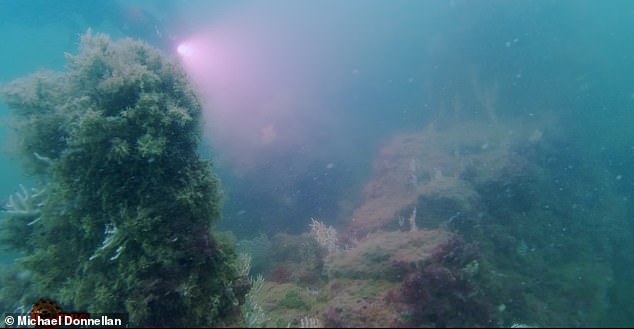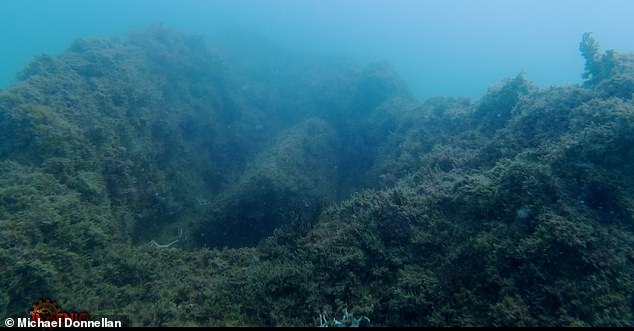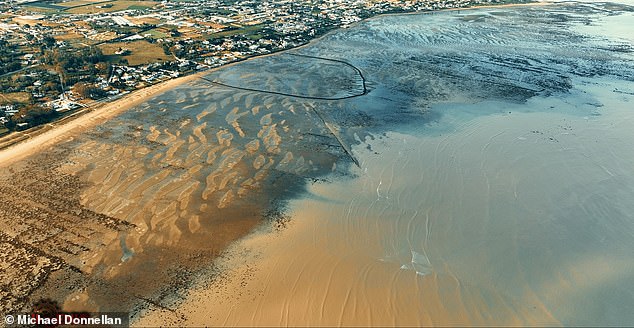Plato’s writings describe an advanced civilization that built grand temples and massive harbor walls before being swallowed by the sea more than 11,600 years ago.
Now, an archaeologist believes he has found Atlantis just two miles off the coast of Cádiz, Spain.
While many scholars dismiss Atlantis as pure myth, Michael Donnellan said the lost city is real, and he has the underwater footage to prove it.
Donnellan made the bombshell announcement at the Cosmic Summit, a North Carolina conference focused on alternative history, where he premiered his upcoming documentary.
He spent eight years investigating the coast of Cádiz using sonar and LiDAR, finally uncovering ‘long, linear structures’ etched across the ocean floor, which formed a series of ‘enormous concentric circular walls,’ each standing more than 20 feet tall and arranged in an organized pattern.
The outermost wall showed the most damage, as if it had been pummeled by a massive tsunami racing in from the sea.
The second and third walls, he said, were ‘completely displaced,’ with scans showing them split into two.
Between the walls sat intricately carved canals, and at the center was a rectangular ruin that, according to Donnellan, echoes Plato’s description of Poseidon’s temple, forming what he believes is the capital city of Atlantis.

A new documentary has revealed what is believed to be the lost city of Atlantis. A team of divers found massive structures on the seafloor that they said were made by human hands
Michael Donnellan, an archaeologist and filmmaker, has spent eight years investigating what he believes is the city of Atlantis off the coast of Spain
‘We are calling it the great ancient Atlantic culture, it is much easier to believe in,’ Donnellan told the Daily Mail.
‘I think that’s a gateway to letting people slowly, over time, take the word Atlantis much more seriously.’
In scenes from the documentary, Donnellan and his team dive into murky waters and quickly ‘come face-to-face with the first wall.’
He described the submerged structure as having sharp right angles, flat surfaces, and a uniform width measuring a few feet thick.
A closer look allowed Donnellan to see what he said were cut stones placed one on top of the other.
‘It matches everything Plato says verbatim,’ Donnellan said.
‘He says it came from outside the straits in the region known by the Greeks, 2,400 years ago, as Gades. We know that perfectly well to this day that Gades is the modern-day Cádiz, which happens to be the oldest city in western Europe.’
Plato’s story of Atlantis appears primarily in Timaeus and Critias, written around 360 BC.
He describes a mighty island nation located beyond the Pillars of Heracles, the ancient name for the Strait of Gibraltar, situated in the Atlantic Ocean, across from the Mediterranean.
In Critias, Plato writes that Atlas, the first king of Atlantis, ruled with his twin brother Gadeirus. Together, they divided the island’s territory, overseeing a land rich in resources, palatial architecture, and a complex network of canals and harbors.

The discovery was made just two miles off the coast of Cádiz, Spain, which is the oldest city in western Europe
Massive structures were found around 65 feet below the surface. The team also identified ‘long, linear structures’ etched across the ocean floor
But as the tale goes, the Atlanteans grew greedy and corrupt, and the gods punished them.
Plato wrote that the entire island was wiped out by a massive earthquake and flood, disappearing beneath the waves.
‘Plato words it very well, he says, ‘that in a day and a night of earthquakes and floods,’ Donnellan said.
The archaeologist and filmmaker admitted that historians do not know what caused the terrible events, but pointed to the idea of the Younger Dryas, a controversial period proposed to have ended around 11,600 BC.
The archaeologist said his discovery matches what Plato wrote, which the philosopher says came from outside the straits in the region known by the Greeks, 2,400 years ago, as Gades. We know that perfectly well to this day that Gades is the modern-day Cádiz

Between the walls sat intricately carved canals, and at the center was a rectangular ruin that, according to Donnellan, echoes Plato’s description of Poseidon’s temple, forming what he believes is the capital city of Atlantis
While not widely accepted by mainstream scholars, some fringe researchers have linked it to a cataclysmic event that may have wiped out a forgotten advanced civilization.
Over 20 dives, Donnellan and his team uncovered even more tantalizing clues, smaller walls toppled across the seabed, canals, cut channels and scattered stones he believes were ‘flung’ from their original construction site.
The crew stumbled upon huge stones, about half the size of a small car, that were perfectly rectangular.
‘There are countless artifacts that are consistent with an ancient metropolis,’ said Donnellan. ‘The style of construction, however, is certainly not Roman nor Venetian.
‘And at this distance and depth, it would make this place much, much older.’
He also noted that the dimensions of the submerged city match those written down by Plato.

The crew stumbled upon huge stones, about half the size of a small car, that were perfectly rectangular
Over 20 dives, Donnellan and his team uncovered even more tantalizing clues, smaller walls toppled across the seabed, canals, cut channels and scattered stones he believes were ‘flung’ from their original construction site
According to the philosopher, Atlantis was 3,000 stadia long and 2,000 stadia wide, which equals 341 miles by 227 miles, about the size of Nevada.
The archaeologist has only scanned one quarter of the entire city, finding that their discovery closely aligns with the ancient measurements.
Near the upper acropolis, the scans capture ‘remains of distinct structures,’ such as what appeared to be buildings.
But at the center, Donnellan spotted a rectangular formation of massive proportions, oriented perfectly to the cardinal points.
Plato describes Atlantis as having a geometrically planned city, with concentric circles of land and water centered around a central acropolis.
He also notes that the central plain was ‘rectangular and for the most part straight and oblong in shape, and it was oriented north-south.’
